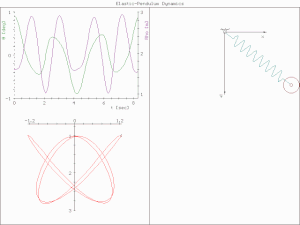Informatics Educational Institutions & Programs
Contents

In physics and mathematics, in the area of dynamical systems, an elastic pendulum[1][2] (also called spring pendulum[3][4] or swinging spring) is a physical system where a piece of mass is connected to a spring so that the resulting motion contains elements of both a simple pendulum and a one-dimensional spring-mass system.[2] For specific energy values, the system demonstrates all the hallmarks of chaotic behavior and is sensitive to initial conditions.[2]At very low and very high energy, there also appears to be regular motion. [5]The motion of an elastic pendulum is governed by a set of coupled ordinary differential equations.This behavior suggests a complex interplay between energy states and system dynamics.
Analysis and interpretation

The system is much more complex than a simple pendulum, as the properties of the spring add an extra dimension of freedom to the system. For example, when the spring compresses, the shorter radius causes the spring to move faster due to the conservation of angular momentum. It is also possible that the spring has a range that is overtaken by the motion of the pendulum, making it practically neutral to the motion of the pendulum.
Lagrangian
The spring has the rest length and can be stretched by a length . The angle of oscillation of the pendulum is .
The Lagrangian is:
where is the kinetic energy and is the potential energy.
Hooke's law is the potential energy of the spring itself:
where is the spring constant.
The potential energy from gravity, on the other hand, is determined by the height of the mass. For a given angle and displacement, the potential energy is:
where is the gravitational acceleration.
The kinetic energy is given by:
where is the velocity of the mass. To relate to the other variables, the velocity is written as a combination of a movement along and perpendicular to the spring:
So the Lagrangian becomes:[1]
Equations of motion
With two degrees of freedom, for and , the equations of motion can be found using two Euler-Lagrange equations:
For :[1]
isolated:
And for :[1]
isolated:
The elastic pendulum is now described with two coupled ordinary differential equations. These can be solved numerically. Furthermore, one can use analytical methods to study the intriguing phenomenon of order-chaos-order[7] in this system.
See also
References
- ^ a b c d Xiao, Qisong; et al. "Dynamics of the Elastic Pendulum" (PDF).
- ^ a b c Pokorny, Pavel (2008). "Stability Condition for Vertical Oscillation of 3-dim Heavy Spring Elastic Pendulum" (PDF). Regular and Chaotic Dynamics. 13 (3): 155–165. Bibcode:2008RCD....13..155P. doi:10.1134/S1560354708030027. S2CID 56090968.
- ^ Sivasrinivas, Kolukula. "Spring Pendulum".
- ^ Hill, Christian (19 July 2017). "The spring pendulum".
- ^ Leah, Ganis. The Swinging Spring: Regular and Chaotic Motion.
- ^ Simionescu, P.A. (2014). Computer Aided Graphing and Simulation Tools for AutoCAD Users (1st ed.). Boca Raton, Florida: CRC Press. ISBN 978-1-4822-5290-3.
- ^ Anurag, Anurag; Basudeb, Mondal; Bhattacharjee, Jayanta Kumar; Chakraborty, Sagar (2020). "Understanding the order-chaos-order transition in the planar elastic pendulum". Physica D. 402: 132256. Bibcode:2020PhyD..40232256A. doi:10.1016/j.physd.2019.132256. S2CID 209905775.
Further reading
- Pokorny, Pavel (2008). "Stability Condition for Vertical Oscillation of 3-dim Heavy Spring Elastic Pendulum" (PDF). Regular and Chaotic Dynamics. 13 (3): 155–165. Bibcode:2008RCD....13..155P. doi:10.1134/S1560354708030027. S2CID 56090968.
- Pokorny, Pavel (2009). "Continuation of Periodic Solutions of Dissipative and Conservative Systems: Application to Elastic Pendulum" (PDF). Mathematical Problems in Engineering. 2009: 1–15. doi:10.1155/2009/104547.
External links
- Holovatsky V., Holovatska Y. (2019) "Oscillations of an elastic pendulum" (interactive animation), Wolfram Demonstrations Project, published February 19, 2019.
- Holovatsky V., Holovatskyi I., Holovatska Ya., Struk Ya. Oscillations of the resonant elastic pendulum. Physics and Educational Technology, 2023, 1, 10–17, https://doi.org/10.32782/pet-2023-1-2 http://journals.vnu.volyn.ua/index.php/physics/article/view/1093































![{\displaystyle L[x,{\dot {x}},\theta ,{\dot {\theta }}]={\frac {1}{2}}m({\dot {x}}^{2}+(l_{0}+x)^{2}{\dot {\theta }}^{2})-{\frac {1}{2}}kx^{2}+gm(l_{0}+x)\cos \theta }](https://wikimedia.org/api/rest_v1/media/math/render/svg/51844c7831278ecdfb989c51b95d780d91a0fa1f)











